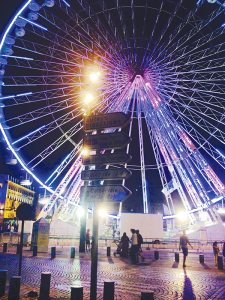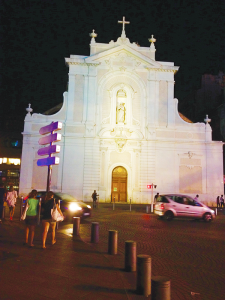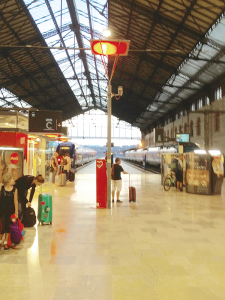The Serendipity of Senior Train Travel
By Michele Reed
michele@cny55.com
Photos by Bill Reed

Sometimes you plan an adventure and other times, it just sneaks up on you.
We had enjoyed our stay in Nice, France, (October/November issue) and were planning on a six-hour train ride back to our city of Beziers, arriving in late evening. The leg from Nice to Marseille was about three hours, where we would have to change trains for the final portion.
When our Nice train was delayed, we worried we may not have enough time to make our connection. Luckily for us, the Marseille station is one of the few where the platforms are all together on one level. Every other station we’d been in required going down a steep flight of stairs through an underground passage to climb another steep flight to the next platform — hard work for seniors!
As we pulled into Marseille, we realized we had only two minutes to find our platform and our train had stopped well outside the center of the station. We ran, literally, lugging our baggage to locate the big illuminated sign that would tell us where our train was waiting. French trains all run pretty much on time and they have one frustrating quality. Often you do not know your platform until only a couple of minutes before the train leaves. We scanned the sign and saw our train number — but instead of “a l’heure,” on time, or “retard,” late, this time it said “supprime.” We didn’t know what that word meant. Panic gripped us for a moment. Had our train already left the station? We hurried to a conductor who explained the news, which was even worse. Our train hadn’t left. In fact, no trains would be traveling in that direction.
A freak summer hailstorm, lasting only 15 minutes, had uprooted a tree, which crashed into a train on our line, derailing it. “People are all over the tracks,” he told us. He suggested the rail system would give us all a train car to sleep overnight. We joined dozens of people in line to exchange tickets. When it turned out the delay would be two days, they didn’t even offer a train berth. And that was a good thing! What senior would want to sleep for two nights in a coach seat with a shared train bathroom and no shower facilities?
I griped quite a bit about our delay, but Bill, my husband, reminded me: “You are the luckiest girl in the world!” If our cousin hadn’t booked a late flight out of Nice, we would have opted for an earlier train to Beziers, hoping to arrive before the buses stopped running — the difference between a 30 cent bus ride home and a $30 taxi. We would have been on that earlier train and possibly among the eight people who had been gravely injured and were in intensive care.

Google and TripAdvisor apps to the rescue, and Bill found a 4-star hotel in the heart of Marseille’s old town.
The city has a reputation as a rough port and with good reason. In the 1960s and 1970s it was the infamous French Connection, feeding the pipeline of drugs to the US. The mob ruled. In recent years, Marseille has done much to polish its image and appeal to visitors. Still, Google maps led us through a very rough neighborhood, and we were thankful it was still light. Later we would learn the difference was only a block or two! If we turned right in front of our hotel, all was fine. If we turned left, it was a bit sketchy.
Making the most of our surprise stopover, we headed for the Old Port, which has now become a tourist destination. We were greeted by a huge illuminated Ferris wheel, offering views of the city from on high. A craft fair stretched along the harborside. Trendy restaurants lined the wharf, serving everything from bouillabaisse, the city’s famous hearty fish soup, to Provençal specialties.
Thanks to the desk clerk at our hotel, we had a prime restaurant recommendation: La Pulpe, which means the octopus. We walked almost to the end of the harbor, but it was worth the hike. Wicker couches and chairs on the terrace offered a view of the port with a pleasant sea breeze. Our meal of a Provençal octopus stew with onion, eggplant, garlic and of course, the tentacled sea creature, was delicious, and was accompanied by a local white wine.
The next day we were excited to find that the Marseille History Museum was literally next door to our hotel. Although the city has several museums and historical sites, the choice was a no-brainer. Less of a hike meant more time to enjoy the exhibits. As in many places in France we asked for and received the senior discount. Instead of 13 euros we paid only 5 to see the museum and a special exhibit about underwater archaeology and shipwrecks. The regular museum traced the history of Marseille back to 600 BC when it was settled by the ancient Greeks. I was fascinated by a poster from 1899 celebrating the 2,500th anniversary of the city’s founding.

We refreshed ourselves with a beer at a brasserie at the corner of the wharf, a prime location for people watching. Across the street was the white limestone church of St. Ferreol les Augustins, owned by the Templars in the 1300s and almost destroyed twice, by the French Revolution and 19th Century street construction. Auspiciously, it was open, so we entered to light a candle of thanksgiving for being fortunate enough to be on the later train.
Our visit to Marseille ended with a delicious meal at a seaside café next to the old city hall. Our first course of little fried fishes included what seemed like a hundred tiny fish, piled onto the plate like onion straws. Bill followed that with a Provence seafood stew, and I had Aioli Provençale, a plate of steamed carrots, cauliflower and potatoes, mussels, crayfish and hardboiled egg, served with rich, garlicky aioli, a mayonnaise-like sauce, for dipping.
We sat watching the sunset illuminate the gold-leafed statue of the Virgin Mary atop the church of Notre Dame de la Garde, which sits high on a hill overlooking the harbor. Gazing at Fort Saint Nicholas on one side of the historic port and Fort Saint Jean on the other, we started planning our next adventure there.
And to think that it all happened because of a tree on the tracks!
Michele Reed retired after a career spanning four decades in public relations, advertising, journalism and higher education. She now writes travel articles, book reviews, haiku poetry and fiction. Bill Reed retired after four decades in social services with the county of Oswego, and now works at travel photography and photojournalism, along with writing book reviews.

